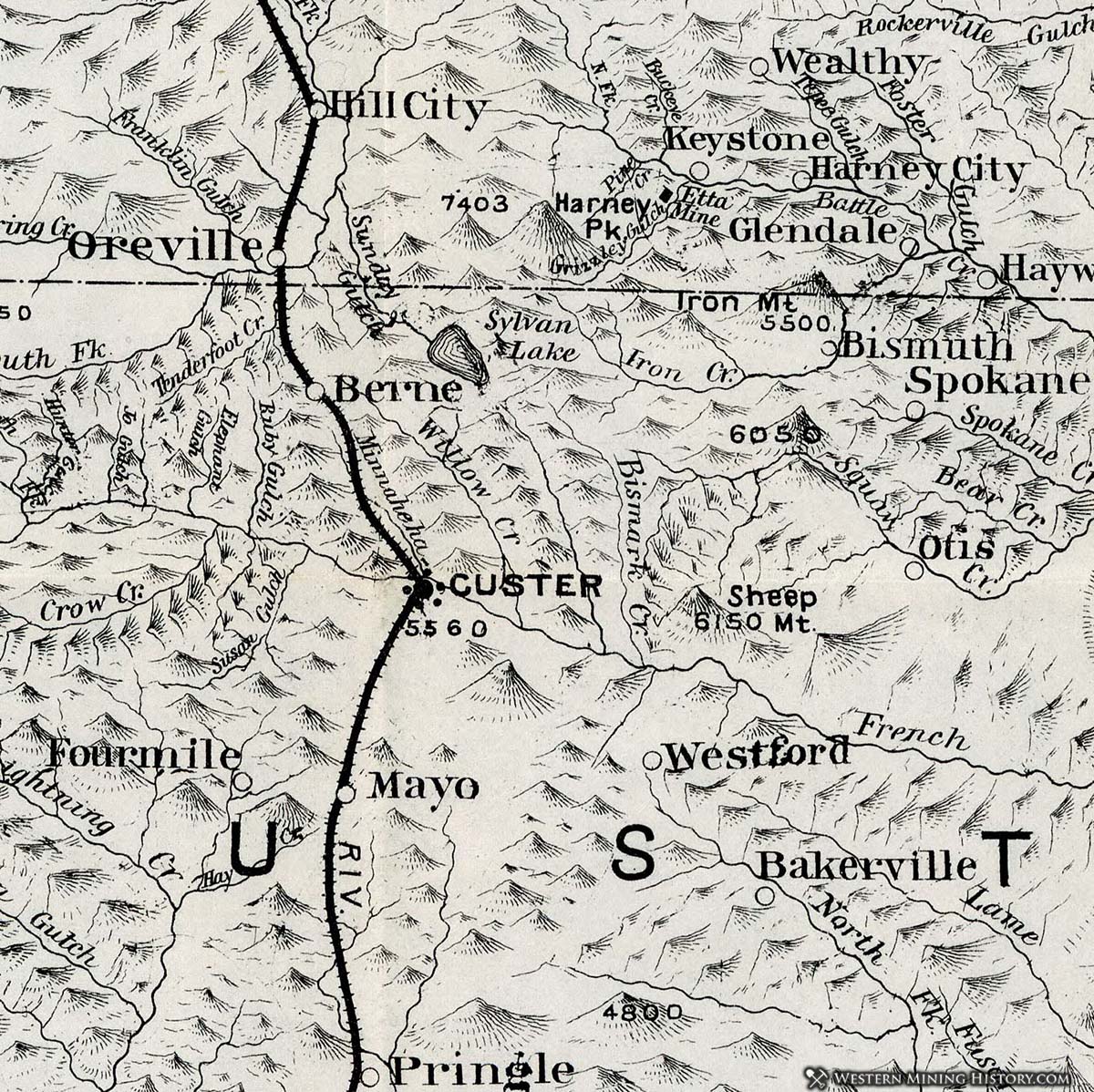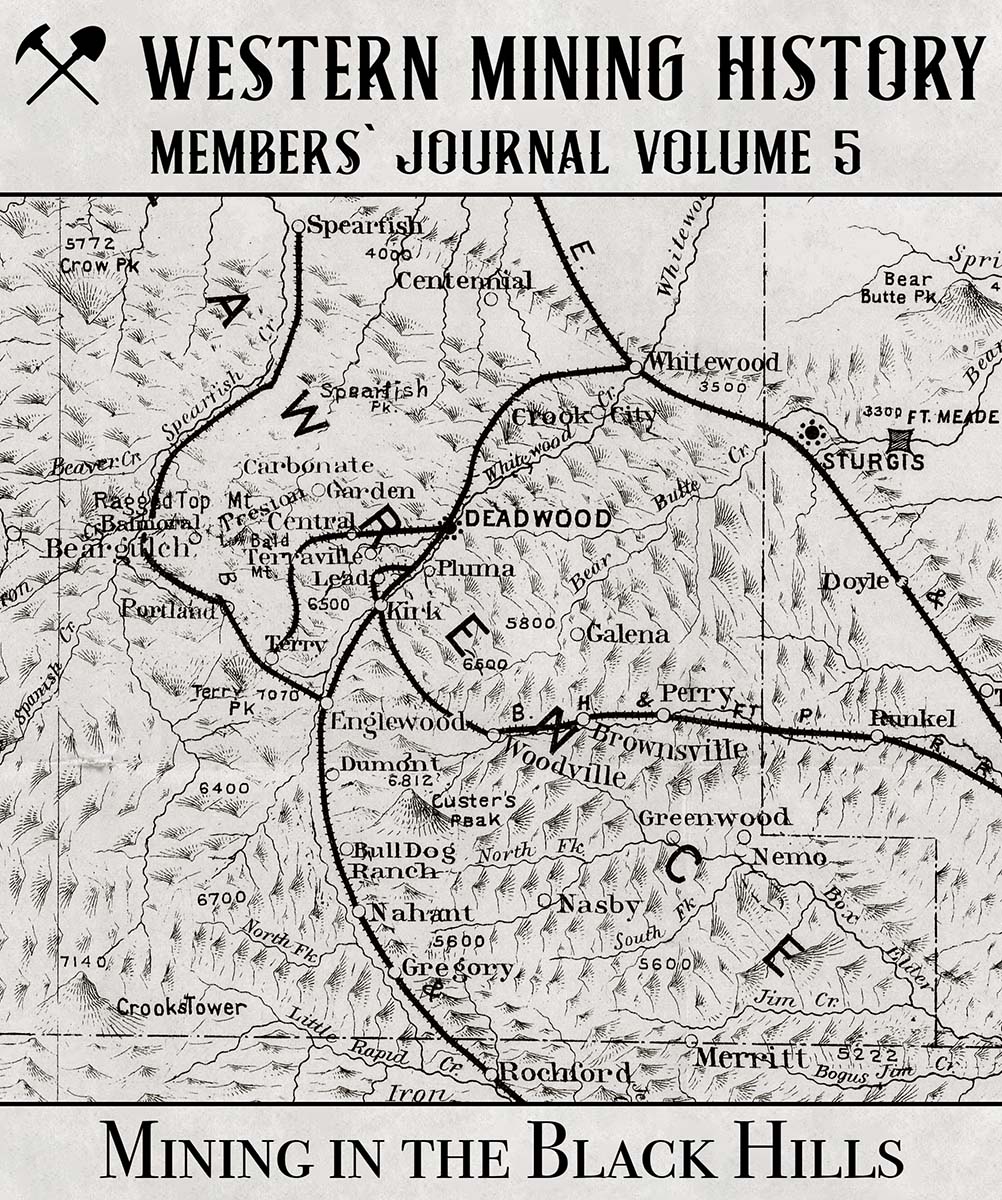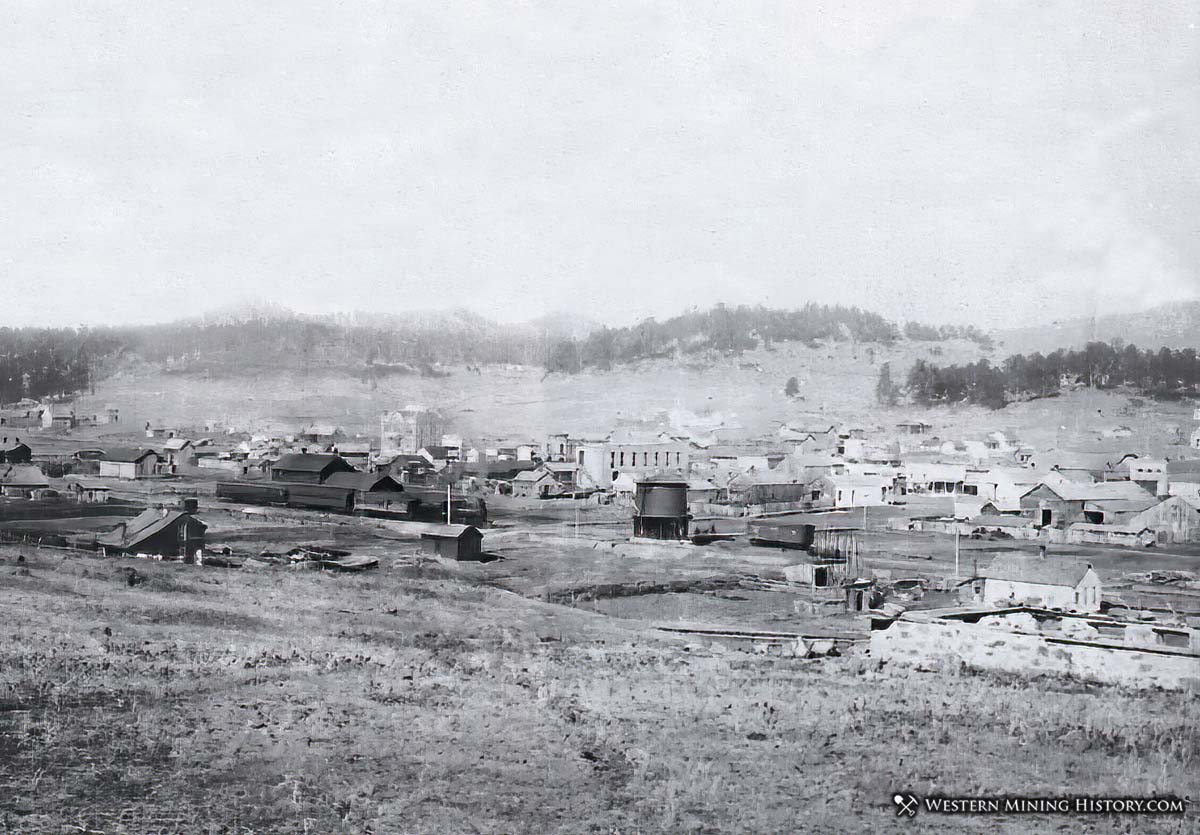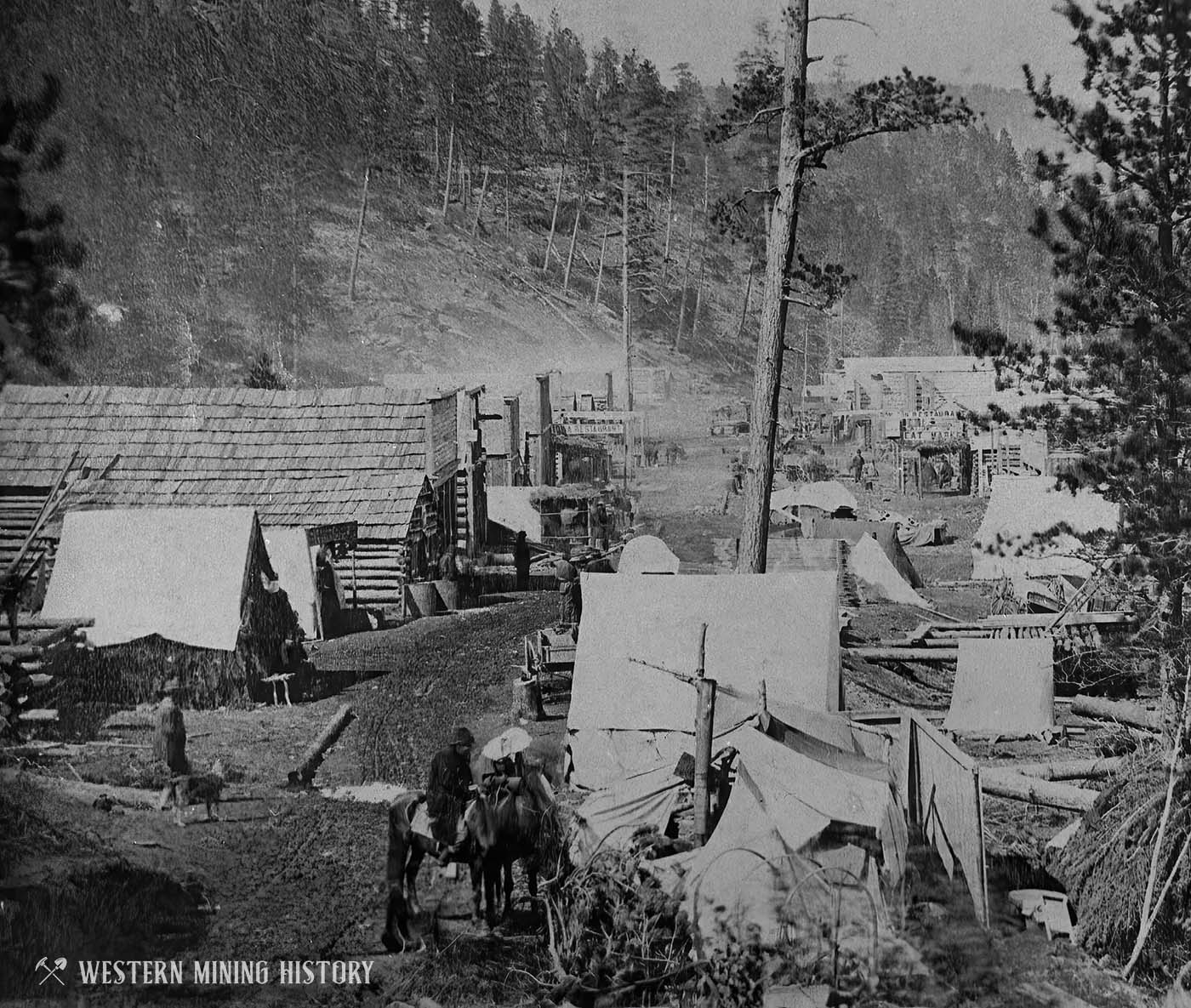Custer History
Custer holds a special place in the history of the Black Hills as it was the location of the first settlement. This is the site of the placer gold discovery in early 1875 that ultimately led to the great Black Hills Gold rush.
Custer had two distinct periods in its early history. The initial rush was said to have resulted in a population of 6,000-10,000 by March of 1876. This period ended quickly however as word of the spectacular gold discoveries in Deadwood Gulch almost emptied the town overnight of most of it's inhabitants.
As the goldfields of the northern Black Hills were inundated with prospectors, and all promising ground was claimed, men began returning to the Custer area in search better prospects. By summer of 1877 Custer was once again a viable town, with around 500 residents. A post office was established that year.
While Custer did have a gold mining industry that lasted for decades, it seems that the mines were very small compared with those in districts to the north. The USGS does not credit any district in Custer County with gold production of more than 10,000 ounces.
Between gold mining and later the mining of industrial minerals like feldspar and mica, Custer remained a viable town when others were abandoned. Today Custer remains an active town with around 1,900 residents.

Early History of Custer
The following text is a selection from the 1904 publication Black Hills Illustrated.
Nearly twenty-nine years have elapsed since the writer first inhaled the exhilarating air of the Black Hills and gazed with rapture upon their marvelous scenic beauty and pristine loveliness. At this early period in our history the surpassing magnificence of the natural scenery had not been marred by the rude hand of the miner, the grand picture being still in that attractive and fascinating state of perfection in which the deft and faultless hand of nature had left it, a marvel of scenic beauty and matchless grandeur.
It was in the fall of 1874 when the report of Gen. Custer's expedition, which contained a mention of the discovery of gold in the Black Hills, created a considerable degree of excitement throughout the country, resulting in the formation of what was known as the Gordon party, which was formed at Sioux City, Iowa, with a view to determining the then mooted question as to the presence of gold in the Black Hills in paying quantity. This historic party succeeded in perfecting its arrangements for the trip late in the fall of the year named, arriving in the Hills in December.
They established their camp on French creek, at a point three miles below Custer, where they at once proceeded to erect an elaborate stockade for protection against Indian invasion, inside of which were erected six cabins for the comfort and convenience of the party. In the mean- time, pending the building of the stockade, two of their number were engaged in prospecting for gold, which was found in quantity suffi- cient to justify further pursuit.
Having fully imbibed the opinion that the region was one of exceptional promise, Mr. Gordon returned to Sioux City, accompanied by another member of the party whose name was Witcher, and spread the glad tidings of their golden discoveries, which largely increased the measure of public excitement. The result was the formation of a number of expeditions for the new Eldorado during the month of April, notwithstanding the knowledge of the fact that the Gordon party had been taken out of the Hills by government direction.
At this critical period in our history the portals to the region were doubly sealed, and in addition to the strong opposition of the Indians, the stronger opposition of the government had intervened, making it extremely difficult, and even dangerous, to make the trip. This, however, did not deter the more resolute and determined souls, who pursued their course, not even halting when they learned that a large party in advance had been taken into custody by order of the government, their wagons and outfits, including their guns, ammunition and all of their personal effects, destroyed by fire, and the members of the party taken as prisoners under guard to a military post for trial.
Notwithstanding the obstacles which beset the pathway of these avant couriers of civilization, no less than 1,200 had reached their destination before the 10th of August, the time appointed for the departure of all the so-called trespassers upon the sacred rights of the great Sioux nation from the Hills, in accord- ance with a proclamation issued by Gen. Crook, who, with his escort, was at that time present and personally supervising this unhappy affair.By and with the consent of Gen. Crook, seven men were permitted to remain in the country for the purpose of looking after the interest of the outgoing miners. These men took up their residence at the Gordon stockade, where they remained until November 16, when they departed with Capt. Pollock and his command for Red Cloud, returning to the Hills early in December. The departure of Capt. Pollock and his command, who had been guarding the re- gion against the so-called recalcitrant miners from August 10, was followed by a still greater influx of people, who, it is pleasing to note, did not have to contend with further government interference.
Custer, the pioneer city of the Black Hills, had by this time gained considerable notoriety, having been originally organized in July under the name of Stonewall, reorganized and rechristened under the name of Custer City in August, and again reorganized in December. It was not, however, until early in the month of January of the following year, 1876, that the building of the city may be said to have been fairly under way.
As early as March, 1876, Custer's population was variously estimated at from 6,000 to 10,000, and her fame had spread all over the country. Under a provisional government the city progressed rapidly, assuming an air of metropolitan greatness that would have made much more populous cities of the outside world fairly envious by comparison. Her official directory embraced all of the officials necessary to conduct the municipal affairs of a city of ten times its population, including five police judges and a judge of the Superior court, from whose august decision there was no possible appeal.
This was what may be termed Custer's boom period, which augmented as the days multiplied, invoked the wildest dreams as to her brilliant future. But alas! the fond hopes of the enthusiastic citizens were turned to ashes by the discovery of gold galore in Deadwood gulch, which resulted in one of the most remarkable heigiras ever experienced in the west. The gilded reports of rich gold strikes in the northern Hills in a few brief days had done its deadly work, and the proud city, with its great expectations and lofty hopes, was practically abandoned, as there remained but fourteen souls to hold the fort and await reinforcements from the outside world.
There were at this time 1,400 buildings, all told, in the place, just an even 100 to each inhabitant. The remaining fourteen, realizing the danger of an Indian attack, constructed breast-works for their protection and awaited the turn of future events. It was three long and dreary weeks before their number was in any measure increased, and then only by a small number. Later on occasional additions swelled the population to a few hundred, when the work of mining development and other business ventures were resumed.
Custer Described in 1904
After the exodus to Deadwood, when only fourteen people were left in the original townsite, others began to dribble in during the year of 1877 from the expeditions to Deadwood; and previous to this, in 1876, after the Custer massacre, the camping on the town site of General Crook's army on its return gave a small impetus to population. Thus, in 1877, Custer numbered from 500 to 600 souls. Since then it has grown by degrees, until now there are about 1,000 inhabitants.
Custer is the county seat of Custer county. The city has good waterworks, which were completed last year. purposes, it is supplied by an acetylene gas plant of large capacity. It numbers two banks and two newspapers, the latter being weeklies. There are five general stores, carrying almost everything, and two very good hotels. The surrounding farming and stock-raising, which are of the best and confined mainly to the surrounding valleys, called parks, and the lumber industry furnish a very large trade for the merchants.
Henry Robinson of Akron, O., built the mill of the Akron Mining and Milling Company in Custer about 1890, to grind mica and make grease. But finally began to make car and bridge paint from ochre. It is shipped dry to Aurora, Ill., and then mixed with oils and sold to railway companies. The combined company employs about 30 men. The Custer plant cost from $40,000 to $50,000.
Mining in the Black Hills

Western Mining History Member's Journal Volume 5: "Mining in the Black Hills", takes a closer look at the distribution of mining districts and towns the Black Hills of South Dakota.
Deadwood: The Ultimate Photo Collection
The Black Hills Gold Rush was one of the most significant historical events in the western United States. Deadwood: The Ultimate Photo Collection contains over 50 images capturing the early history of this famous gold region.

